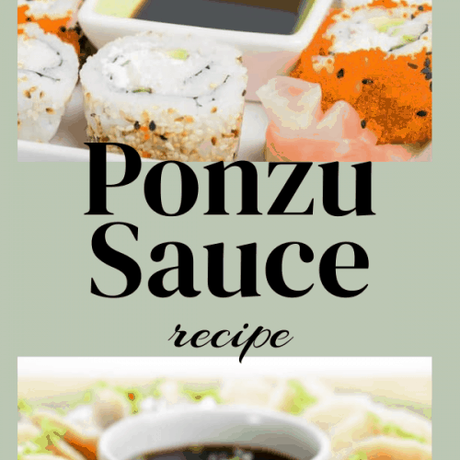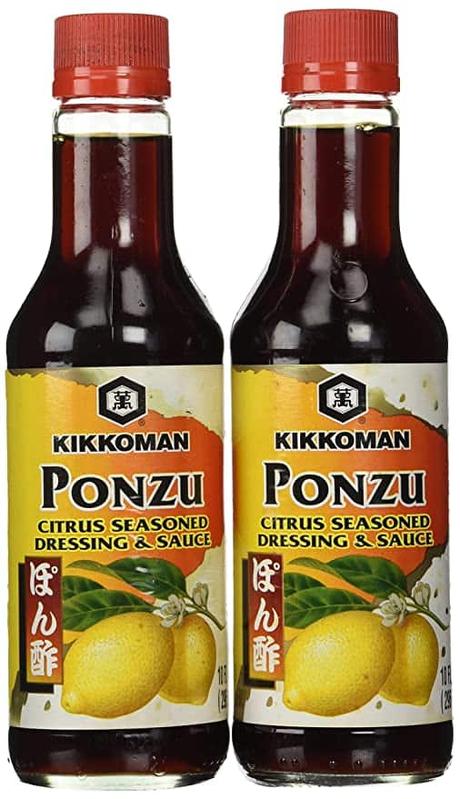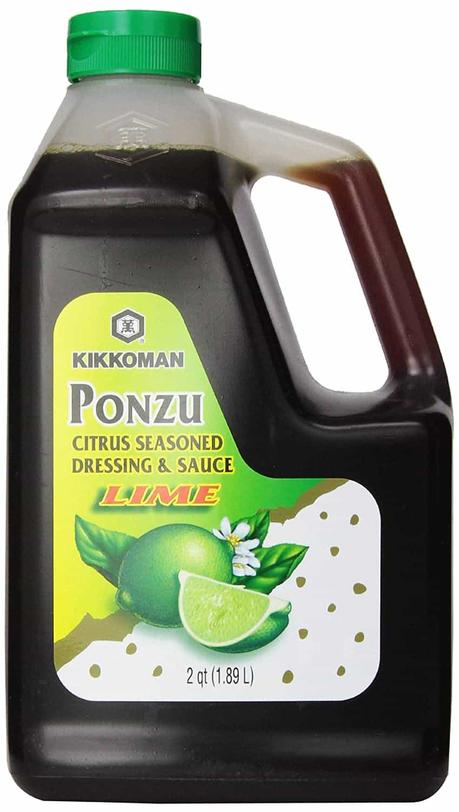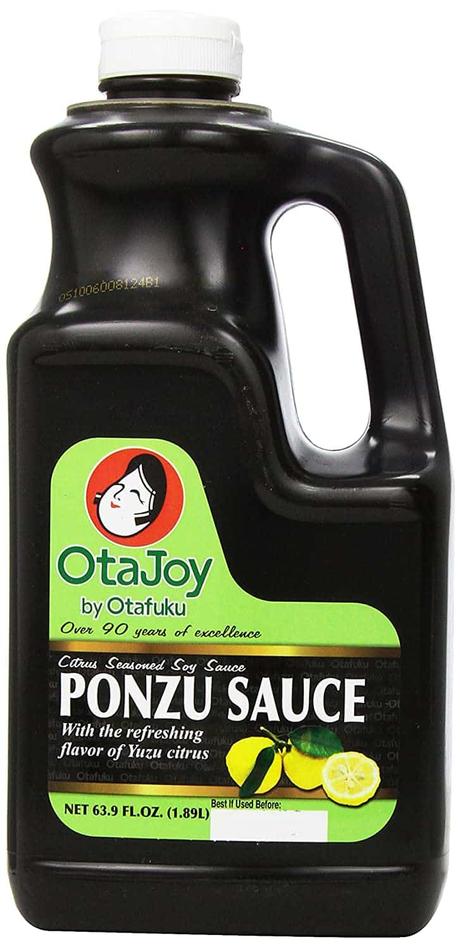If you enjoy adding flavor to your Japanese cuisine, it’s likely you have tried Ponzu sauce.
The sauce is citrus-based and it is made by mixing mirin, rice vinegar, katsuobushi flakes and seaweed and letting them steep overnight.

Once the liquid is cooled and strained, citrus fruit juices are added.
The sauce has a tart, salty, savory taste and a thin watery texture. It is used as a dressing for tataki (lightly grilled and chopped meat or fish). It can also be a dip for nabemono (one pot dishes) and sashimi. It is also a popular topping for Takoyaki.
Read on to find out everything you’ve ever wanted to know about this tasty sauce.
Where did Ponzu sauce come from?
No one is really sure how ponzu sauce originated. However, there is some information on the origin of its name.
Pon comes from the Dutch word ‘punch’. It is one of the few words that still has an influence on the Japanese language.
This dates back to the 17th century when the Dutch East India Company were the only Westerners welcome to trade with isolationist Japan.
Zu means vinegar so the two mixed together suggests the sauce has a punchy acidic taste.
Although there is a Dutch influence on the name, the ingredients and method of cooking are purely Japanese.
 Print
Print
How to Make Ponzu Sauce
Now you know a bit about ponzu sauce but a recipe will help you get a better understanding of what goes into this condiment. Here is a recipe that is recommended. Course Side DishCuisine JapaneseKeyword Ponzu, Sauce Prep Time 10 minutesSteep 1 dayTotal Time 1 day 10 minutes Servings 4 people Author Joost Nusselder Cost $4Ingredients
- ½ cup soy sauce
- ½ cup citrus juice (juices used can vary according to taste)
- Lemon zest from one lemon
- 2 tbsp mirin
- 1 cup dried bonito flakes (katsuobushi)
- 1 piece kombu (dried kelp)
Instructions
- Combine ingredients in a mason jar and mix well. Steep in refrigerator for 24 hours or up to a week. (Some restaurants will even let their ponzu sauce steep for a month. This is recommended for bigger batches.)
- Drain to get rid of excess bonito flakes. (These can be saved and used to make furikake (Japanese rice seasoning)).
- Use immediately or store. To be safe, ponzu can be stored for one month, but if you keep it away from water, you may be able to store it for 6 – 12 months.
Note: for the citrus juice, there are a number of combinations you can use. Some recommend mixing 6 tbsp. lemon juice with 2 tbsp. orange juice. Grapefruit juice can also add a bit of a zing.
Recipes that use Ponzu sauce
And not only can you make ponzu sauce at home, there are also plenty of recipes you can make that have ponzu sauce in them.
We recommend this one for Chicken Sate with Ponzu Sauce.
Ingredients:
- 4 (6 oz.) skinless, boneless chicken breast halves
- ¼ cup packed light brown sugar
- ¼ cup sake (rice wine)
- ¼ cup rice vinegar
- ¼ cup fresh lemon juice
- 2 tsp. low sodium soy sauce
- 1 tsp. dark sesame oil
- ¼ tsp. crushed red pepper
- 1 clove minced garlic
- Cooking spray
Directions:
- Cut each breast lengthwise to make them into 4 strips each.
- Combine sugar and remaining ingredients except cooking spray in a small bowl. Stir until sugar dissolves. Combine half of the mixture with the chicken in a large bowl and let stand 10 minutes.
- Drain chicken, discard marinade. Thread each chicken strip on to an 8” skewer. Place chicken on grill rack coated with cooking spray and grill two minutes a side. Serve with remaining sake mixture.
How do you use Ponzu sauce?
Ponzu sauce can be used in recipes, but here are some other great ways to incorporate it in meals.
- To Finish a Dish: Right before you are ready to serve a dish, add a few dashes of ponzu sauce. It will elevate the flavors of a stew or stir fry.
- In a Marinade: Adding ponzu sauce to a marinade can give your steak or pork that extra something.
- In a Salad Dressing: Ponzu works well in a dressing served with a mixed green salad.
- As a Dipping Sauce: Ponzu makes a terrific dipping sauce for chicken dumplings and other appetizer-type foods.
- In Burgers: Ponzu sauce can be used to substitute Worcestershire sauce to make any kind of burger tastier. This includes meat burgers, chicken and turkey burgers, and veggie burgers. It is also great in meatloaf.
Ponzu Sauce Nutrition
Ponzu sauce does not rank very high on the nutrition scale. If you look at a nutrition label on a bottle of sauce, you will see that it contains none of the necessary daily nutrients.
It is also high in sodium making it not the best choice for those on a low salt diet.
On the bright side, it is low in calories (only around 10 calories for a 1 tbsp. serving) and it is fat-free.
Ponzu sauce is also not vegan due to its fish flakes. It contains soy sauce which has wheat in it.
Therefore, it is not gluten-free. Due to its high sugar content, it is also not keto-friendly.
Beste Ponzu Sauce Substitutes
If you are making a recipe that calls for ponzu sauce and you don’t have any, and you don’t have the ingredients to whip it up on your own, here are few worthwhile substitutes.
Worcestershire Sauce
Worcestershire sauce is probably the best ponzu substitute.
It contains tamarind and anchovies which provide a taste that is similar to that of the citrus juice and bonito flakes.
Some even say that Worcestershire sauce was made to replicate ponzu.
The only drawback is the Worcestershire does not quite have that light, clean taste that comes from ponzu’s distinct spices.
Shoyu
Shoyu is Japanese soy sauce. Bother shoyu and soy sauce can work as a substitute for ponzu but shoyu can get you closer to the taste you are looking for.
To make up for the fact that shoyu does not have that same citrusy acidic taste ponzu does, you may want to add some lemon juice.
Nam Prik Pla
Nam prik pla is a Thai condiment made with fish sauce, citrus juice and hot chiles.
Even though the hot chiles make it much spicier than ponzu, the fish sauce and citrus juice tick off the right boxes.
Therefore, you may want to use this as a sort of spicy ponzu.
Spicy Ponzu
And speaking of spicy ponzu, if you like yours with a kick, spicy varieties are available at the grocery store.
You can also make homemade ponzu that is extra spicy by adding sriracha chile sauce or chile oil to the recipe.
To give you an idea, here is an example of a recipe for a spicy ponzu dressing:
Ingredients:
- 1 cup bottled ponzu sauce
- 1 cup soy sauce
- ½ cup mirin
- ½ cup rice vinegar
- 1 5” piece konbu (dried sea kelp)
- 1 tbsp. katsuobushi (dried smoked bonito chips)
- Juice from ½ orange
- 1 tsp. Asian chile oil
- 1 tsp. sriracha chile sauce
- 12 oz. mixed greens including oak leaf, romaine, radicchio, bibb and lola rosa
Directions:
- Combine ponzu sauce, soy sauce, rice wine, vinegar, sea kelp, bonito flakes and orange juice in a medium bowl. Cover with plastic wrap. Put it in the refrigerator to mature for 2 weeks.
- Strain mixture though a fine sieve into a clean jar with a tight fitting lid. Discard solids. (Dressing will keep in refrigerator for up to 3 months.
- Put chile oil, chile sauce and 1/3 cup of ponzu dressing in a large bowl and whisk until smooth. Add greens and toss until well coated.
Best storebought Ponzu sauce
You can make your own ponzu sauce, or you can also buy it at Asian and American grocery stores. It is available in glass or plastic bottles.
If you are looking to buy ponzu sauce in the store, it seems as if Kikkoman has a monopoly on it. Kikkoman offers regular ponzu sauce in various size bottles.

(view more images)
It also has Lime ponzu:

Kikkoman is a trusted brand known for bringing Asian products into American markets. Their ponzu sauce will definitely provide the taste you are looking for.
Ota Joy also has a Ponzu sauce that is worth trying:

(view more images)
Ota Joy has a long history of bringing Japanese food products to markets around the globe.
The company has made a reputation for itself that guarantees high quality and great taste.
Takeaway
Well, now you know what ponzu sauce is, how to make it, where to buy it, what it can be substituted with, its nutrition facts and more.
The only thing you have left to do is try it, or make it for yourself. What will your ponzu sauce culinary adventure entail?
Also read: check out the ingredients lists for these popular sushi sauces
